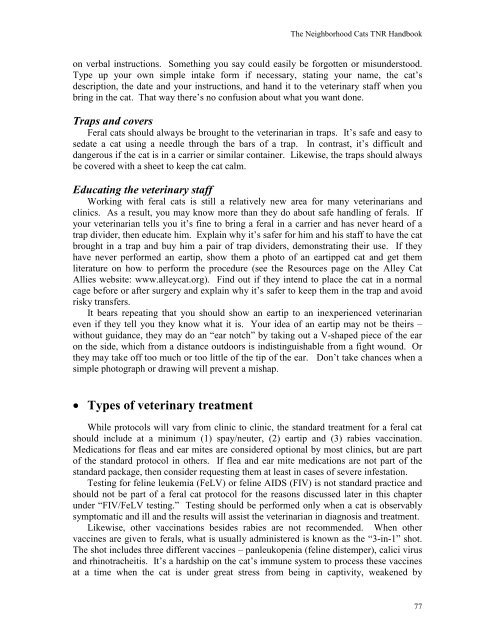Create successful ePaper yourself
Turn your PDF publications into a flip-book with our unique Google optimized e-Paper software.
The <strong>Neighborhood</strong> <strong>Cats</strong> <strong>TNR</strong> <strong>Handbook</strong><br />
on verbal instructions. Something you say could easily be forgotten or misunderstood.<br />
Type up your own simple intake form if necessary, stating your name, the cat’s<br />
description, the date and your instructions, and hand it to the veterinary staff when you<br />
bring in the cat. That way there’s no confusion about what you want done.<br />
Traps and covers<br />
Feral cats should always be brought to the veterinarian in traps. It’s safe and easy to<br />
sedate a cat using a needle through the bars of a trap. In contrast, it’s difficult and<br />
dangerous if the cat is in a carrier or similar container. Likewise, the traps should always<br />
be covered with a sheet to keep the cat calm.<br />
Educating the veterinary staff<br />
Working with feral cats is still a relatively new area for many veterinarians and<br />
clinics. As a result, you may know more than they do about safe handling of ferals. If<br />
your veterinarian tells you it’s fine to bring a feral in a carrier and has never heard of a<br />
trap divider, then educate him. Explain why it’s safer for him and his staff to have the cat<br />
brought in a trap and buy him a pair of trap dividers, demonstrating their use. If they<br />
have never performed an eartip, show them a photo of an eartipped cat and get them<br />
literature on how to perform the procedure (see the Resources page on the Alley Cat<br />
Allies website: www.alleycat.org). Find out if they intend to place the cat in a normal<br />
cage before or after surgery and explain why it’s safer to keep them in the trap and avoid<br />
risky transfers.<br />
It bears repeating that you should show an eartip to an inexperienced veterinarian<br />
even if they tell you they know what it is. Your idea of an eartip may not be theirs –<br />
without guidance, they may do an “ear notch” by taking out a V-shaped piece of the ear<br />
on the side, which from a distance outdoors is indistinguishable from a fight wound. Or<br />
they may take off too much or too little of the tip of the ear. Don’t take chances when a<br />
simple photograph or drawing will prevent a mishap.<br />
• Types of veterinary treatment<br />
While protocols will vary from clinic to clinic, the standard treatment for a feral cat<br />
should include at a minimum (1) spay/neuter, (2) eartip and (3) rabies vaccination.<br />
Medications for fleas and ear mites are considered optional by most clinics, but are part<br />
of the standard protocol in others. If flea and ear mite medications are not part of the<br />
standard package, then consider requesting them at least in cases of severe infestation.<br />
Testing for feline leukemia (FeLV) or feline AIDS (FIV) is not standard practice and<br />
should not be part of a feral cat protocol for the reasons discussed later in this chapter<br />
under “FIV/FeLV testing.” Testing should be performed only when a cat is observably<br />
symptomatic and ill and the results will assist the veterinarian in diagnosis and treatment.<br />
Likewise, other vaccinations besides rabies are not recommended. When other<br />
vaccines are given to ferals, what is usually administered is known as the “3-in-1” shot.<br />
The shot includes three different vaccines – panleukopenia (feline distemper), calici virus<br />
and rhinotracheitis. It’s a hardship on the cat’s immune system to process these vaccines<br />
at a time when the cat is under great stress from being in captivity, weakened by<br />
77


